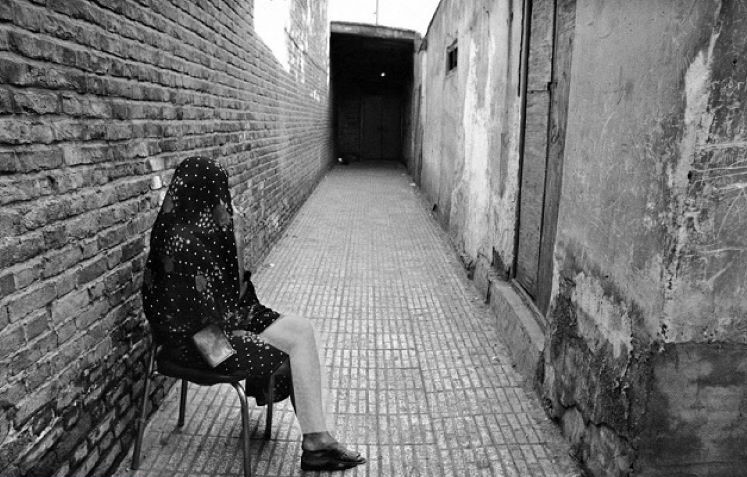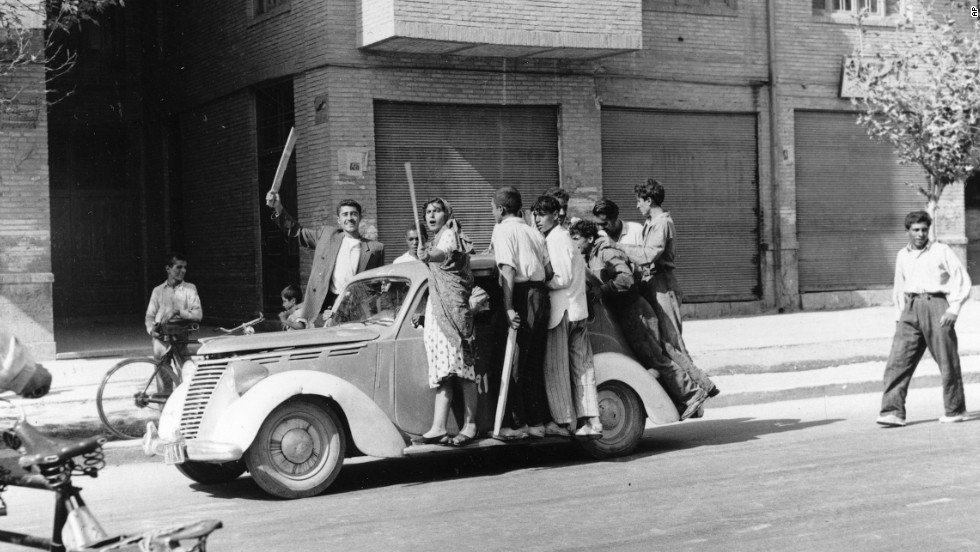Shahr-e No – "the neighbourhood of the sorrowful"

During the reign of Shah Mohammad-Reza Pahlavi (1941-1979), prostitutes in the capital Tehran, often with their children, lived ostracised and marginalised lives in run-down dwellings in the Shahr-e No, or "New City" district on the southern outskirts of the city.
Back in the nineteen twenties and prior to his accession to the throne, Reza Khan – Mohammad-Reza's father – learnt from those close to him that the British were making plans to depose him. The future Shah took it upon himself to put a spoke in their wheel. He knew that two senior British diplomats visited Aziz Kashi's notorious "whorehouse" from time to time. So he ordered his soldiers to surprise them on their next visit there. That was on 8 March 1922. The newspapers reported the incident in detail and the two diplomats left the country in a hurry.
Once Reza Khan ascended the throne, he had much of the Qajar Palace in the centre of Tehran demolished. Those women who lived there in the harem and did not manage to marry wealthy men from the royal family were taken to the Qajar quarter. He subsequently had the quarter expanded to make room for newly arrived prostitutes from various "whorehouses" in Tehran that he had seen fit to close.
This precipitated the establishment of the Shahr-e No neighbourhood, which became home to all of Tehran's prostitutes. Later, under the rule of Reza Shah's son, Mohammad-Reza Pahlavi, a wall was built around the neighbourhood to better control it. Colloquially, it was known as "Ghaleh" (the citadel).
The "citadel of silence"
Those who busied themselves intellectually or artistically with the lives of the women there referred to Shahr-e No as the "citadel of silence" or the "neighbourhood of the sorrowful". Noisy narrow streets, with a cafe here and there, ran through the neighbourhood, which was inhabited by a few hundred women and their children. Each house was run by a madam who was reverently addressed by the residents as "Mistress". She received the money and provided the women with food, lodging and pocket money.
Excerpt from the documentary "Ghaleh" by Kamran Shirdel:
Before being admitted to Shahr-e No, the women had to be assessed by a member of the "Women's Council". Afterwards, they were registered by the neighbourhood police and given both an identity card and a health card. This meant they were registered as residents of the neighbourhood. The health card enabled them to go for a medical check-up once a week.
On admission to one of the houses, the residents had to sign several promissory notes. Because of the amount of debt and the stigma attached to them as "dishonourable" prostitutes, few were ever able to leave. Unauthorised women were unwelcome in Shahr-e No.
A woman's prerogative
At all levels, the "bosses" in Shahr-e No were women. As facilitators who made money from sex, they were little better than male pimps. Yet the pressure they exerted was milder, tending to wear the women down, rather than breaking them. Physical violence was also less pronounced. Male nightclub owners and pimps did try to exert influence in Shahr-e No, but the reins of power remained in the hands of a few influential women and their facilitators, the house madams. Violent crime in the neighbourhood was rare. The most common law-and-order offence was the use of opiates, which was widespread. With it, the prostitutes were better able to endure the suffering and misery.
At that time, extramarital sexual contacts of women or even the birth of an illegitimate child were absolutely taboo. If they were not killed by their males relatives first, such women were cast out as "dishonoured". Even if they had been raped as maids by their masters or, out in the countryside, by the local landowner, their only real option in terms of survival was to become a prostitute in a brothel.Shahr-e No and power
The clients of the prostitutes in Shahr-e No were mainly from the middle, and rarely from the lower classes. Yet there were also solid connections between Shahr-e No and high-ranking officers, not to mention the Shah's inner coterie of statesmen. Some women, among them Maleke Etezadi, made a point of fostering such ties. Etezadi was descended from the Qajar dynasty. Smart, educated and ambitious, she had studied in Paris and was considered a beauty. She had affairs with a number of officers and statesmen and was in and out of the royal palace. It is alleged that she had an affair with Prime Minister Fazlollah Zahedi and may even have been the Shah's mistress for a time.
One of the most influential women in Shahr-e No was Sakine Ghasemi, called "Pari Bolande" (tall Pari). She had dealings not only with influential men and politicians, but also with figures from the criminal underworld. Ghasemi, who was the madam of a house in Shahr-e No, was rich and arrived for work in a chauffeur-driven limousine.
The CIA coup of 1953
Mohammad Mossadegh, a figurehead of the Iranian independence movement, belonged to Iran's privileged educated class. After the fall of Reza Khan in 1941, there was a political opening in Iran. In 1949, Mossadegh and other democratic politicians founded the National Front, an initiative that principally campaigned for the country's independence from Britain. As a member of parliament and, from 1951, as prime minister, he fought for the nationalisation by law of the Iranian oil industry, which until then had been under British control.

This, however, did not sit well with the leadership of Britain and the United States. They advised the Shah to remove Mossadegh and appoint Lieutenant General Fazlollah Zahedi in his place. On 16 August 1953, Mossadegh announced that a coup against the government had been discovered and prevented. Mass demonstrations broke out in Tehran, as a result of which the Shah left Iran.
Three days later, on 19 August 1953, supporters of the Shah, with organised thugs and a crowd of prostitutes from Shahr-e No, set out in private and military vehicles to bring the exiled Shah back to Iran. Maleke Etezadi and Sakine Ghasemi were among the leaders of the mob. Since the almost complete release of CIA documents in 2013, the role of U.S. intelligence in the 1953 coup is considered proven.
Shahr-e No in art
Between 1966 and 1968, three men explored the lives of the prostitutes of Shahr-e No, including the writer and filmmaker Zakaria Hashemi in his novel "The Parrot", of which there have been several editions since.
Two years before the revolution, Hashemi himself made a film of his novel, but the Ministry of Arts and Culture under the Shah did not authorise a public screening of the film.
In 1966, Kamran Shirdel was commissioned by the Iranian Women's Organisation to make the documentary film "Ghaleh" ("The Citadel") about the lives of women in Shahr-e No.
However, the Minister of Culture intervened and put a stop to filming. Shirdel later finished his film with the help of Kaveh Golestan's photos from Shahr-e No .
The photographer and photojournalist Kaveh Golestan had made a study of women from the "citadel" from 1975 to 1977. In 2003, while working as a reporter for the BBC in the U.S. war in Iraq, he was killed in a mine explosion. A selection of his images from the prostitutes' ghetto are now on permanent display at the Tate Modern Gallery in London.
Golestan himself said of the photographs that they were to intended to feel like "a slap in the face".
Nasrin Bassiri